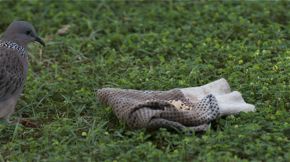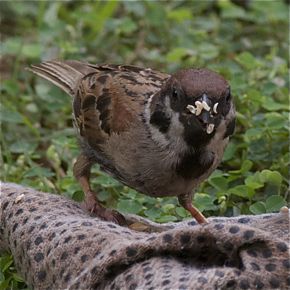The Spotted Dove (Streptopelia chinensis) normally forages on the ground for seeds. So it is comfortable picking up birdseeds scattered in the garden. Its aim is always accurate, seldom missing a seed as it lunged at them with its bill. It has the ability of picking up about a hundred seeds per minute, sometimes much more, especially when seeds are plentiful. When seeds were placed in a container, it was initially reluctant to feed from it. Or was it because it did not notice the seeds inside the container? But eventually it overcame its suspicion and fed from it (above).
I placed some seeds on an old glove, and left it in the garden. I was hoping to make it used to feeding from it and hopefully it would subsequently feed from my hand. For the next few days it avoided the glove. So did the Eurasian Tree Sparrow (Passer montanus). So I folded the “fingers” under so as not to make it appear like a hand. The dove was still suspicious and refused to feed from it although it did approach it once in while (below left). The sparrow on the other hand overcame their fear and soon fed from the folded glove (below right). And every time I placed seeds on the folded glove, the sparrows finished them. The dove, being a popular songbird, is regularly trapped, and so is always cautious of of human hands. Not so the sparrows.
From images examined subsequently, I found that the sparrows somehow “de-husked” the small round seeds, leaving the thin translucent husks stuck to the bird’s bill (below). When the seeds were scattered on the tiled porch, the many husks were obvious on the ground. The dove on the other hand swallowed the seeds whole. The short strong bill allows sparrows to de-husk seeds.
The Spotted Dove has an insatiable appetite for birdseeds. As soon as it had eaten all the seeds, it would approach me. I would then scatter more. And it would eat them all. With a large crop to store the seeds, it obviously picked up all it could get, to slowly process the ingested seeds on a safe perch somewhere. The seeds would then be transferred to the muscular crop containing grit where they would be ground and passed on through the alimentary canal.
Eating such large amount of dry seeds means that the dove needs to drink a large amount of water. This it does by drinking from the large jar of water where I keep my ornamental fishes in the garden. Unlike most other birds, the Spotted Dove as well as other doves and pigeons, drink by immersing its bill into the water and sucking it, rather than scooping up the water with the bill and throwing back its head to allow the water to drain down the throat. This allows doves and pigeons to drink at the shortest time, especially in locations where they may be in danger of being predated.
The few Javan Mynas (Acridotheres javanicus) that appeared in the garden were not interested in the seeds, although reportedly omnivorous.
YC Wee
Singapore
July 2010













5 Responses
I was quite impressed when I realized my backyard sparrows (various) and finches were actually cracking open each tiny millet seed and leaving a husk – that is a little seed to “de-husk”. Our North American doves also eat the seed whole which means they can eat them very quickly – a good competitive edge on the sparrows!